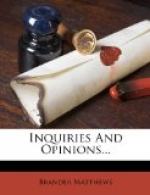About the same time the handsomest horse in the king’s stables escaped; and the chief huntsman, meeting Zadig, inquired if he had not seen the animal. And Zadig responded: “It is the horse that gallops the best; he is five feet high; his shoe is very small; his tail is three and a half feet long; the knobs of his bit are of twenty-three-carat gold; and he is shod with eleven-penny silver.” And the chief huntsman asked, “Which way did he go?” To which Zadig replied: “I have not seen him; and I have never heard anything about him.”
The chief eunuch and the chief huntsman naturally believed that Zadig had stolen the queen’s dog and the king’s horse; so they had him arrested and condemned, first to the knout, and afterward to exile for life in Siberia. And then both the missing animals were recovered; so Zadig was allowed to plead his case. He swore that he had never seen either the dog of the queen or the horse of the king. This is what had happened: He had been walking toward a little wood and he had seen on the sand the track of an animal, and he judged that it had been a dog. Little furrows scratched in the low hillocks of sand between the footprints showed him that it was a female whose teats were pendent, and who therefore must have littered recently. As the sand was less deeply marked by one foot than by the three others, he had perceived the queen’s dog to be lame.
As for the larger quadruped, Zadig, while walking in a narrow path in the wood, had seen the prints of a horse’s shoes, all at an equal distance; and he had said to himself that here was a steed with a perfect stride. The path was narrow, being only seven feet wide, and here and there the dust had been flicked from the trees on either hand, and so Zadig had made sure that the horse had a tail three and a half feet long. The branches crossed over the path at the height of five feet, and as leaves had been broken off, the observer had decided that the horse was just five feet high. As to the bit, this must be of gold, since the horse had rubbed it against a stone, which Zadig had recognized as a touchstone and on which he had assayed the trace of precious metal. And from the marks left by the horse’s shoes on another kind of stone Zadig had felt certain that they were made of eleven-penny silver.
Huxley has pointed out that the method of Zadig is the method which has made possible the incessant scientific discovery of the last century. It is the method of Wellington at Assaye, assuming that there must be a ford at a certain place on the river, because there was a village on each side. It is the method of Grant at Vicksburg, examining the knapsacks of the Confederate soldiers slain in a sortie to see if these contained rations, which would show that the garrison was seeking to break out because the place was untenable. It is also the method of Poe in the ‘Gold-Bug’ and in the ‘Murders of the Rue Morgue.’ In all probability Poe borrowed it directly from Voltaire, who had taken it over from Oriental folklore.




